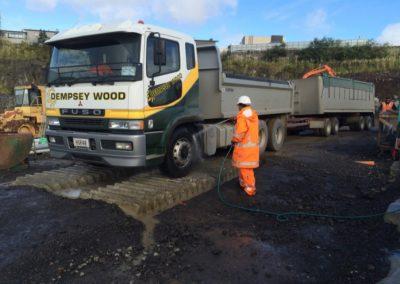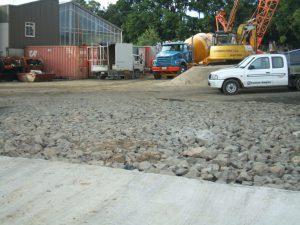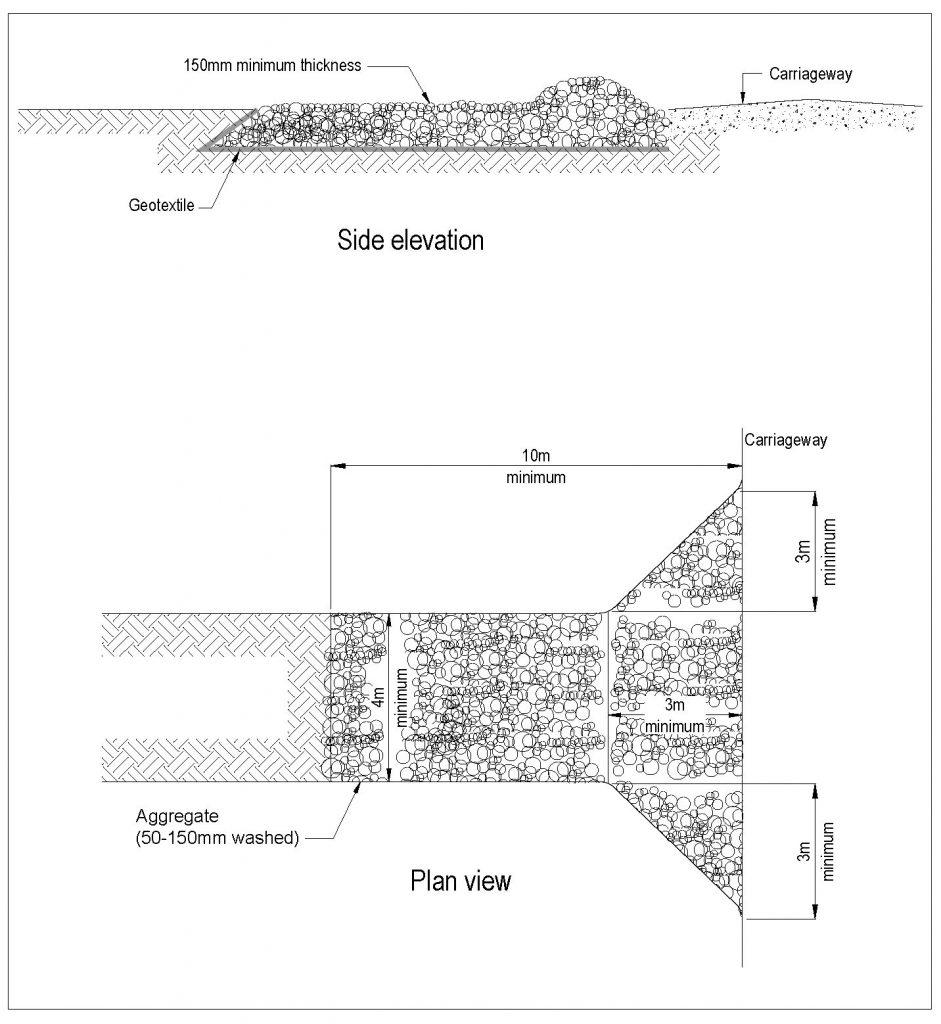Erosion Control
Soil and surface stabilisation practices
Stabilised entranceways
What, why, when and issues to look out for
What
Stabilised entranceways are stabilised areas at any entry or exit of a construction site.
Note: A stabilised entrance way is not designed to remove mud or dirt from the wheels of vehicles exiting the site. If you need to stop sediment being tracked off the site, you will need to add additional measures such as a formal wheel wash or a vibrating cattle-grate system (shaker ramp).
Why
Having an entranceway that is stabilised:
- Stops site access points becoming sources of sediment
- Helps minimise dust generation and disturbance of areas next to the road by providing a defined entry and exit point.
When
Stabilisation should be used at all entry and exit points of construction sites, with traffic movements limited to these points only.
Where necessary, stabilisation may be installed in association with shaker ramps or wheel wash facilities, as close as possible to the boundary of the works area.
Issues to look out for
Stabilised entranceways have the following limitations:
- They reduce sediment movement but will not remove sediment from a vehicle. You will need other management techniques – eg wheel wash, stabilised parking and turnaround areas within the site – to keep site traffic ‘clean’ and reduce the potential for vehicles to transport sediment onto the road.
- Using a wheel-wash system alongside a stabilised entranceway can be expensive, but will remove more sediment.
- Site management of traffic (ie preventing vehicles becoming a source of sediment by creating stabilised site parking, turnaround and laydown areas inside the site) is generally more cost efficient and effective in preventing sediment being tracked offsite than a wheel wash.
- Don’t put stabilised entranceways in areas of concentrated flows, or next to watercourses or stormwater catchpits.
Design essentials
Formal design of stabilised entranceways is not usually needed. However, you still must meet the following design essentials for the tool to work:
- Stabilised entranceways do not have to be at the permanent site entry/exit point.
- Locate all stabilised entrance ways so that vehicles cannot bypass them. Using perimeter silt fences or bunds may help with this.
- Minimise the number of site exit points.
- Show the locations of all site exits in the ESC Plan.
- Make sure that the stabilised entrance drains back onto site. You could use a speed hump to do this.
- Consider how long the site entry/exit will be in place and the expected traffic volumes and types. For projects that are longer or have large numbers of vehicle movements on and off the site, it is often more cost efficient to seal the exits at the start of the project than manage constant maintenance.
- Use the design and specifications to design stabilised entranceways. Achieving the specifications detailed below on a small site may be difficult, look under Specific tasks for guidance.
| Design parameter | Specification |
|---|---|
| Aggregate size | 50–150 mm washed aggregate |
| Minimum thickness | 150 mm |
| Minimum length | 10 m |
| Minimum width | 4 m |
When stabilised entranceways are used with a shaker ramp
- Shaker ramps need to be at least 5 m long to allow at least one full revolution of a truck tyre
- When using cattle stops, use two – one in front of the other – to provide adequate length
- Make sure that the ‘teeth’ of the shaker ramp are deep enough so that the material dropped from one vehicle is not picked up by the next
- Stabilise with rock the section of access road between the shaker ramp and the sealed pavement
- Make sure that the runoff from the shaker ramp area and/or wheel-wash system passes through an appropriate sediment retention device.
Note: Shaker ramps are only effective for minor volumes of dry material. If the material to be removed is wet and or is within the tyre treads, it will usually take wheel washing to remove it.
-

Example of truck wash and shaker ramp (Source: SouthernSkies).
-

Example of a shaker ramp (Source: Contractor’s-Services LLC).
When stabilised entranceways are used with a wheel wash
- Provide a water collection and disposal methodology (such as water recirculation)
- Direct wheel-wash runoff to an appropriate sediment retention facility within the site.
Construction and operation
When constructing and operating stabilised entranceways
- Once you have chosen a suitable location for the entranceway, clear the area of unsuitable material and grade the base to a smooth finish.
- Put woven geotextile over this area and pin and overlap it as necessary.
- Put aggregate from the construction site boundary for at least 10 m. The aggregate must be clean and free of fine particles. Contour it to suit the entrance point. (Note: contouring can include a highpoint to stop water flowing out of the site).
- Provide drainage from the stabilised entranceway to an appropriate discharge point. If using a wheel wash, you might also need a sediment retention measure.
- For projects that are longer or have large numbers of vehicle movements on and off the site, it is often more cost efficient to seal the exits at the start of the project than manage constant maintenance.
Watch a stabilised entrance way being installed:
Maintenance and decommissioning
When maintaining stabilised entranceways
- Inspect weekly and after each rainfall event to see if maintenance is needed.
- Maintain the stabilised entranceway in a condition that prevents sediment from leaving the site. You might need to apply new aggregate.
- After each rainfall, inspect any structure used to trap runoff from the stabilised entranceway and clean out as necessary.
- When wheel washing is also required, do this on an area stabilised with aggregate or hotmix, which drains to an approved sediment retention facility. Note: This sediment retention device should be isolated from additional surface flows and/or be specifically designed to include the additional flows from the wheel wash.
- Add further aggregate as necessary when mud blockage becomes evident or when aggregate thickness is not to specification.
- Remove sediment from sealed pavements by sweeping or vacuuming.
- Do not wash any sediment into the stormwater system or any watercourse.
- You might also need regular street sweeping on adjacent roads.
When decommissioning stabilised entranceways
Remove aggregate and geotextile, and stabilise the area. Keep traffic off the area until permanent stabilisation is effective.

